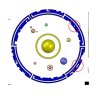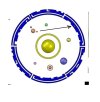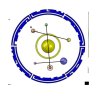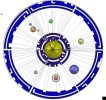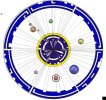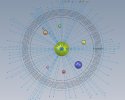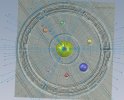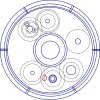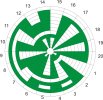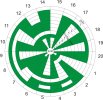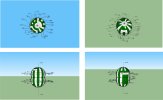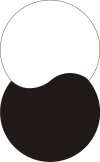Haiku
Jedi Master
I am looking at modeling crop circles in a 3D modeling software, SolidWorks. I am getting crop pictures from this site, http://temporarytemples.co.uk/crop-circles/2015-crop-circles . Using an image importing into my modeling program, enlarged so that the tracks in the field are to my 150” dimension (see assumptions below). My first problem is that the images are not going to be straight up perpendicular to the field, they are skewed a little. I will be fudging the data a little, just for you to know. Once I model this in 3D, I plan on animating it so it will orbit like planets in a solar system or electrons in a molecule. This first one was interesting to me so I started there. It is the one at Maiden Castle in 2015. I chose this one as I was wanting one with external information to support defining it. The ring around the center is loaded with information, similar symbols in varied locations, and more to figure out. I will start here and model the basic structure and simulate it. I am in no way an expert in crop circles, I can model them. I do have my own thoughts about them which I will present …
If there is a someone or a group working on this, please I would be very interested in assisting in any way possible. If not, then I am looking for others that can assist in deciphering and selecting projects. I figure that I am not the first person to investigate this, so I hope that there will be plenty of minds here with similar thoughts.
My assumptions are;
1. This field is rather large to begin with and I suspect that a combine, or similar equipment, was in use here. Standard combine dimensions vary and after a little research I found them to be roughly 150” (3.75M) ± 10”. If there is any other information on this, I am interested to hear it or actual dimensions from each field. I have modeled the crop circle to size. All helps …
2. I am using the widest points in the image as the diameter of the objects. My want of simpler spherical items for this first one is why I selected it.
3. Once I get the largest diameter defined, I am going to tweak the image by stretching it and forcing it round … er.
4. The animation is going to be a constant speed directly of the modeled objects. I suspect that there is information loaded in the outer ring. I figure that it is extremely important to the correct simulation/display of this crop circle and/or understanding of the presented data.
Alright I have finished a rough version of my first project. It took some time and I want to keep going on it, but I am stopping here. I have crude and quick animations that I have attached. It seems to me that this is a static image, not a moving image. Open the PDF first, it gives general information. I have it showing in 3 versions, I am not sure which one to present, so you get all ways. The image is the one I built this field from. The planetary positions for the day of the event, also shown (I added this but do not want those to only see it as this). I also added a markup of the PDF of what I think about this crop circle, please do not open until you think about what is being presented. The colors were applied with no intent of identification.
Why am I doing this now? I have been doing my homework and re-reading everything, this is something that I came across from varied sessions and is something that I can assist with. I will need help and guidance. Haiku …
If there is a someone or a group working on this, please I would be very interested in assisting in any way possible. If not, then I am looking for others that can assist in deciphering and selecting projects. I figure that I am not the first person to investigate this, so I hope that there will be plenty of minds here with similar thoughts.
My assumptions are;
1. This field is rather large to begin with and I suspect that a combine, or similar equipment, was in use here. Standard combine dimensions vary and after a little research I found them to be roughly 150” (3.75M) ± 10”. If there is any other information on this, I am interested to hear it or actual dimensions from each field. I have modeled the crop circle to size. All helps …
2. I am using the widest points in the image as the diameter of the objects. My want of simpler spherical items for this first one is why I selected it.
3. Once I get the largest diameter defined, I am going to tweak the image by stretching it and forcing it round … er.
4. The animation is going to be a constant speed directly of the modeled objects. I suspect that there is information loaded in the outer ring. I figure that it is extremely important to the correct simulation/display of this crop circle and/or understanding of the presented data.
Alright I have finished a rough version of my first project. It took some time and I want to keep going on it, but I am stopping here. I have crude and quick animations that I have attached. It seems to me that this is a static image, not a moving image. Open the PDF first, it gives general information. I have it showing in 3 versions, I am not sure which one to present, so you get all ways. The image is the one I built this field from. The planetary positions for the day of the event, also shown (I added this but do not want those to only see it as this). I also added a markup of the PDF of what I think about this crop circle, please do not open until you think about what is being presented. The colors were applied with no intent of identification.
Why am I doing this now? I have been doing my homework and re-reading everything, this is something that I came across from varied sessions and is something that I can assist with. I will need help and guidance. Haiku …

